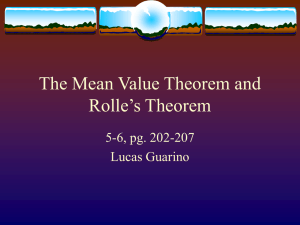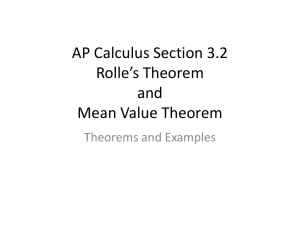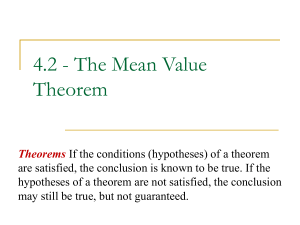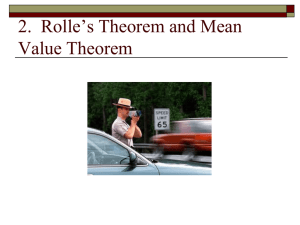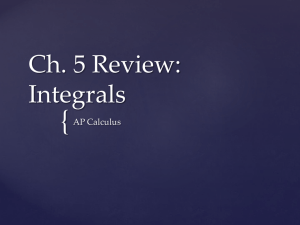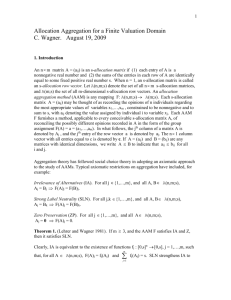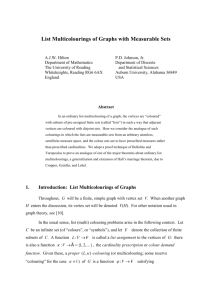Section 5.5 - Mean Value Theorem
advertisement
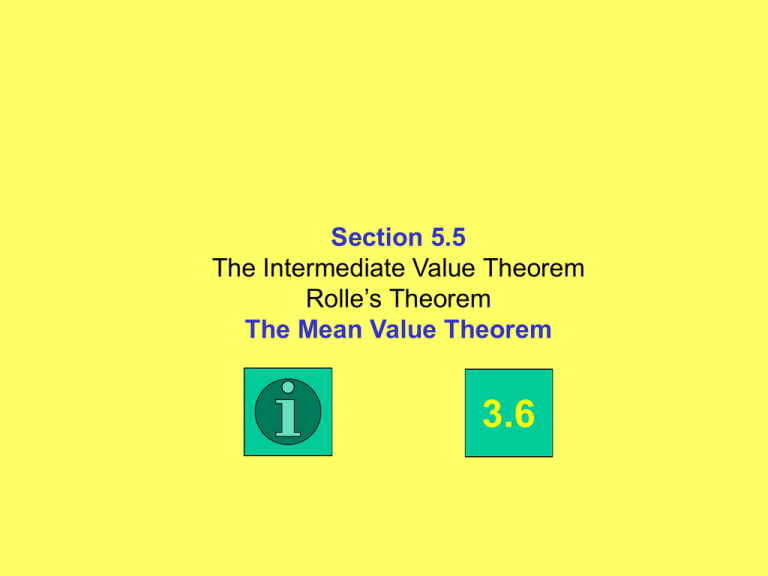
Section 5.5 The Intermediate Value Theorem Rolle’s Theorem The Mean Value Theorem 3.6 Intermediate Value Theorem (IVT) If f is continuous on [a, b] and N is a value between f(a) and f(b), then there is at least one point c between a and b where f takes on the value N. f(b) N f(a) a c b Rolle’s Theorem If f is continuous on [a, b], if f(a) = 0, f(b) = 0, then there is at least one number c on (a, b) where f ‘ (c ) = 0 slope = 0 f ‘ (c ) = 0 a c b Given the curve: mtan lim h0 f x h f x h f(x+h) x x+h f(x) msec f x h f x h The Mean Value Theorem (MVT) aka the ‘crooked’ Rolle’s Theorem If f is continuous on [a, b] and differentiable on (a, b) There is at least one number c on (a, b) at which f b f a f ' c ba Conclusion: Slope of Secant Line Equals Slope of Tangent Line f(b) a c b f(a) If f x x 2x 1, a 0, b 1, and 2 f(0) = -1 f b f a ba f b f a ba f(1) = 2 2 1 1 0 f ' x 2x 2 3 2x 2 1 x 2 3 f ' c , find c. Find the value(s) of c which satisfy Rolle’s Theorem for f x x 4 x on the interval [0, 1]. Verify…..f(0) = 0 – 0 = 0 f(1) = 1 – 1 = 0 f ' x 4x3 1 0 4x3 1 c 3 1 4 which is on [0, 1] Find the value(s) of c that satisfy the Mean Value Theorem for 1 f x x on 4, 4 x 1 17 f 4 4 4 4 1 17 f 4 4 4 4 17 17 f b f a 4 4 17 ba 4 4 16 17 1 f ' c 1 2 16 x Find the value(s) of c that satisfy the Mean Value Theorem for 1 f x x on 4, 4 x Note: The Mean Value Theorem requires the function to be continuous on [-4, 4] and differentiable on (-4, 4). Therefore, since f(x) is discontinuous at x = 0 which is on [-4, 4], there may be no value of c which satisfies the Mean Value Theorem 1 1 2 has no real solution, there is no value of c on Since 16 x [-4, 4] which satisfies the Mean Value Theorem Given the graph of f(x) below, use the graph of f to estimate the numbers on [0, 3.5] which satisfy the conclusion of the Mean Value Theorem. Determine whether f x x 2 2x 2 satisfies the hypothesis of the Mean Value Theorem on -2, 2. If it does, find all numbers c in (a, b) such that f ' c f b f a ba f(x) is continuous and differentiable on [-2, 2] f 2 f 2 2 2 6 2 4 2 f ' x 2x 2 2x 2 2 c 0 On the interval [-2, 2], c = 0 satisfies the conclusion of MVT x2 1 Determine whether f x satisfies the hypothesis of x2 the Mean Value Theorem on -2, 1. If it does, find all numbers c in (a, b) such that f ' c f b f a ba f(x) is continuous and differentiable on [-2, 1] 3 0 1 f 1 f 2 4 1 2 3 4 f 'x 2x x 2 1 x 2 1 x 2 2 x 2 4x 1 1 2 2 2 3x 12x 0 4x 16x 4 x 4x 4 2 x 4x 4 4 3x x 4 0 On the interval [-2, 1], c = 0 satisfies the conclusion of MVT x2 1 Determine whether f x satisfies the hypothesis of x2 the Mean Value Theorem on 0, 4 . If it does, find all numbers c in (a, b) such that f ' c f b f a ba Since f(x) is discontinuous at x = 2, which is part of the interval [0, 4], the Mean Value Theorem does not apply Determine whether f x x 3 3x 1 satisfies the hypothesis of the Mean Value Theorem on -1, 2. If it does, find all numbers c in (a, b) such that f ' c f b f a ba f(x) is continuous and differentiable on [-1, 2] f 2 f 1 2 1 33 0 3 f ' x 3x 2 3 3x2 3 0 3 x 1 x 1 0 c = 1 satisfies the conclusion of MVT CALCULATOR REQUIRED If f x x 2 12 x 2 4 , how many numbers on [-2, 3] satisfy the conclusion of the Mean Value Theorem. A. 0 B. 1 C. 2 D. 3 E. 4 f(3) = 39 f b f a f(-2) = 64 64 39 5 ba 2 3 For how many value(s) of c is f ‘ (c ) = -5? X X X


